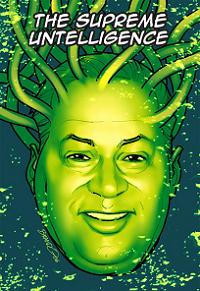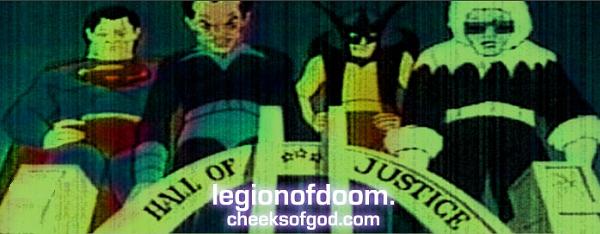Post by kinglear on Oct 19, 2005 20:21:04 GMT -5
Chirp...

Black Canary
Name: Dinah Drake
Base of Operations: A large American city
Profession: Florist
First Appearance: Flash Comics #86, August 1947
Origin: The Black Canary's origin appears to have been undocumented in the Golden Age. In her first adventure, however, she impersonated a petty thief in order to gain the trust of more important criminals. In doing so she crossed paths with Johnny Thunder, who (presumably like most male readers) immediately fell in love with her. Even though The Black Canary's feelings for Johnny were strictly platonic, the two often pursued cases together. The Black Canary even accompanied Johnny to Justice Society of America meetings. Eventually The Black Canary and Harlequin rescued the Justice Society from the new Injustice Society of the World (in the classic "Case of the Patriotic Crimes" from All-Star Comics #41, June-July 1948), winning her a membership in that organisation.
Powers: The Black Canary was a skilled martial artist, quite able to hold her own against much larger men. She also kept various tools (such as lock picks) and weapons hidden in her costume. The Black Canary was also a skilled detective, solving many cases that the police could not.
History: Black Canary debuted in Flash Comics #86, August 1947 as a supporting character in Johnny Thunder's comic strip. She was the creation of Bob Kanigher and Carmine Infantino. It appears that the introduction of The Black Canary was part of a larger trend in the comic book industry towards superheroines in the mid to late Forties. Established superheroines gained new leases on life, while new superheroines were introduced to the world. The Black Cat, long a mainstay of Harvey's Speed Comics, finally received her own solo title in June-July 1946. That same year, in the fall, Timely introduced The Blonde Phantom in All-Select Comics #11--she would take over the magazine entirely with the next issue. August 1947 not only saw the debut of The Black Canary, but Victor Fox's reintroduction of an old Quality Comics heroine, The Phantom Lady. That November Miss Masque debuted in Nedor's Fighting Yank #22. In each of these cases, the superheroines were not fashioned in the Wonder Woman mould. They lacked any superpowers whatsoever, instead depending upon various martial arts and an array of various weapons. The Black Cat was a black belt in karate. The Phantom Lady depended upon her "black light (a device which created darkness)" and considerable fighting skills to catch criminals off guard. Both Miss Masque and The Phantom Blonde carried guns.
While many of the heroines introduced during this period failed to have lasting power, The Black Canary proved to be an immediate hit. Not only did she become a regular in Johnny Thunder's strip in Flash Comics, but she also accompanied Johnny to Justice Society of America meetings. starting with All-Star Comics #38, December 1947-January 1948. In fact, The Black Canary proved so popular that eventually she took over Johnny Thunder's comic strip entirely. Flash Comics #92, February 1948 marked the first of the Black Canary's solo adventures. That July she won her membership in the Justice Society of America by saving the JSA from the Injustice Society of the World in the classic "Case of the Patriotic Crimes (All-Star Comics #41)."
The Black Canary would appear in every issue of Flash Comics until it ended its run with issue 104 in February 1949. Thereafter she could still be seen as a member of the Justice Society of America in All-Star Comics. She made her last Golden Age appearance in the final Justice Society of America story in All-Star Comics #57, February-March 1951. She would be one of the first Golden Age characters reintroduced in the Silver Age. The Black Canary appeared in a two page flashback in Flash #129, June 1962 and would make her first real appearance in over 12 years in the first JLA/JSA team up in Justice League of America issues 21, August-September 1963, and 22, October-December 1963.
Polly want a cracker?


Black Canary
Name: Dinah Drake
Base of Operations: A large American city
Profession: Florist
First Appearance: Flash Comics #86, August 1947
Origin: The Black Canary's origin appears to have been undocumented in the Golden Age. In her first adventure, however, she impersonated a petty thief in order to gain the trust of more important criminals. In doing so she crossed paths with Johnny Thunder, who (presumably like most male readers) immediately fell in love with her. Even though The Black Canary's feelings for Johnny were strictly platonic, the two often pursued cases together. The Black Canary even accompanied Johnny to Justice Society of America meetings. Eventually The Black Canary and Harlequin rescued the Justice Society from the new Injustice Society of the World (in the classic "Case of the Patriotic Crimes" from All-Star Comics #41, June-July 1948), winning her a membership in that organisation.
Powers: The Black Canary was a skilled martial artist, quite able to hold her own against much larger men. She also kept various tools (such as lock picks) and weapons hidden in her costume. The Black Canary was also a skilled detective, solving many cases that the police could not.
History: Black Canary debuted in Flash Comics #86, August 1947 as a supporting character in Johnny Thunder's comic strip. She was the creation of Bob Kanigher and Carmine Infantino. It appears that the introduction of The Black Canary was part of a larger trend in the comic book industry towards superheroines in the mid to late Forties. Established superheroines gained new leases on life, while new superheroines were introduced to the world. The Black Cat, long a mainstay of Harvey's Speed Comics, finally received her own solo title in June-July 1946. That same year, in the fall, Timely introduced The Blonde Phantom in All-Select Comics #11--she would take over the magazine entirely with the next issue. August 1947 not only saw the debut of The Black Canary, but Victor Fox's reintroduction of an old Quality Comics heroine, The Phantom Lady. That November Miss Masque debuted in Nedor's Fighting Yank #22. In each of these cases, the superheroines were not fashioned in the Wonder Woman mould. They lacked any superpowers whatsoever, instead depending upon various martial arts and an array of various weapons. The Black Cat was a black belt in karate. The Phantom Lady depended upon her "black light (a device which created darkness)" and considerable fighting skills to catch criminals off guard. Both Miss Masque and The Phantom Blonde carried guns.
While many of the heroines introduced during this period failed to have lasting power, The Black Canary proved to be an immediate hit. Not only did she become a regular in Johnny Thunder's strip in Flash Comics, but she also accompanied Johnny to Justice Society of America meetings. starting with All-Star Comics #38, December 1947-January 1948. In fact, The Black Canary proved so popular that eventually she took over Johnny Thunder's comic strip entirely. Flash Comics #92, February 1948 marked the first of the Black Canary's solo adventures. That July she won her membership in the Justice Society of America by saving the JSA from the Injustice Society of the World in the classic "Case of the Patriotic Crimes (All-Star Comics #41)."
The Black Canary would appear in every issue of Flash Comics until it ended its run with issue 104 in February 1949. Thereafter she could still be seen as a member of the Justice Society of America in All-Star Comics. She made her last Golden Age appearance in the final Justice Society of America story in All-Star Comics #57, February-March 1951. She would be one of the first Golden Age characters reintroduced in the Silver Age. The Black Canary appeared in a two page flashback in Flash #129, June 1962 and would make her first real appearance in over 12 years in the first JLA/JSA team up in Justice League of America issues 21, August-September 1963, and 22, October-December 1963.
Polly want a cracker?











